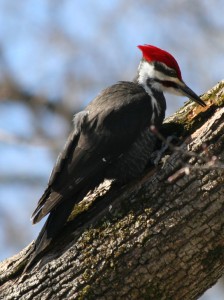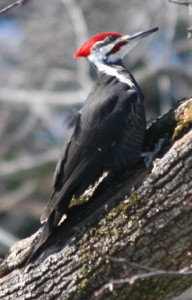Pileated Woodpecker – Dryocopus Pileatus
General:
Once you have seen the Pileated Woodpecker in the wild, watched it climb trees and fly through the forest you will always be able to  identify it. I know of no other bird that size and with that silhouette. As far as woodpeckers go, this is the largest North American woodpecker there is. Like other woodpeckers, its excavating plays a crucial role in many forest ecosystems in North America. A diverse array of other animals use its cavities for shelter and nesting.
identify it. I know of no other bird that size and with that silhouette. As far as woodpeckers go, this is the largest North American woodpecker there is. Like other woodpeckers, its excavating plays a crucial role in many forest ecosystems in North America. A diverse array of other animals use its cavities for shelter and nesting.
Pileated Woodpeckers excavate large nests in the cavities of dead trees. Females lay approximately 1–6 white eggs. Incubation is approximately 15-18 days. The chicks are born naked and helpless. They fledge in about 26-28 days
Their call is a loud cuk-cuk-cuk-cuk. It is very similar to the Northern Flicker.
Identification:
The Pileated Woodpecker Adults are 16” to 19” long with a wingspan of 26” to 30” and weigh 8 to 12 oz. They are almost crow sized. It is best recognized by its large, dull black body, red crest on the head and a white line down the sides of the throat. The males have a red line from the bill to the throat, in adult females these are black. In flight the wings show pale bases to primaries on upper-wing and entirely white under-wing covert.
 Habitat: Pileated Woodpeckers inhabit deciduous and coniferous forests with mature stands of trees. They can be found in suburban areas and farmland with stands of trees. I live in a small Upstate New York town. The pictures are of a bird that was on a neighbor’s maple tree digging for ants and grubs.
Habitat: Pileated Woodpeckers inhabit deciduous and coniferous forests with mature stands of trees. They can be found in suburban areas and farmland with stands of trees. I live in a small Upstate New York town. The pictures are of a bird that was on a neighbor’s maple tree digging for ants and grubs.
Territory:
Pileated Woodpecker’s territory ranges from eastern North America to the Gulf coast, the Great Lakes, the boreal forests of Canada, and parts of the Pacific coast.
Migration:
Pileated Woodpeckers are year round residents of their territories.
Food:
Pileated Woodpeckers eat insects, carpenter ants, wood-boring beetle larvae and to a lesser extent fruits, and nuts. They often chip out large and roughly rectangular holes in trees while searching out insects
Footnote